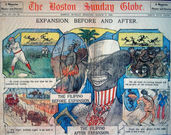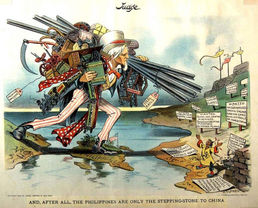

THE PHILIPPINE AMERICAN WAR
Dear Reader
In the Philippines when I was growing up, our history lessons focused on the Philippine revolution against Spain and the heroism of revolutionaries who sacrificed all to win our freedom. 12 June is our Independence Day, even though we hardly had a chance to enjoy freedom before our exhausted revolutionaries found themselves fighting another, unequal war with the United States. The Philippine American War is important not just to Filipinos but to the rest of the world because it marks the moment the United States assumed its current role as world superpower. For us Filipinos though, it is a moment that continues to impact our lives and identities wherever in the world we live.
And yet it is a forgotten piece of history. I chose the Philippine American War as the historical setting of Bone Talk because I wanted to explore this missing jigsaw piece of my story.
This page is a Primer on the war that stole independence from right under our noses – and that still shackles our sense of self as a nation. I have included informative videos by Kirby Araullo and Crash Course, plus political cartoons of the 1900s to help us ponder the public attitudes of the era. I have depended on Arnaldo Dumindin's Filipino American War site for guidance on the detail of the war. Check it out to find a wealth of facts and photographs.
Candy Gourlay

A REVOLTING SITUATION
The Philippines had been a colony of Spain since 1571. In 1896 the Spanish discover that Filipinos are plotting to bring down their colonial rule via a secret society called the Katipunan. The revolutionaries are spurred by Spanish corruption, oppression and blatant racism, especially of the powerful Spanish religious orders (pictured left are 19th century friars in the Philippines from the Dominican order).

A SURPRISE ON MANILA BAY
Across the Atlantic, another Spanish colony Cuba has begun a fight for freedom. Cuban revolutionaries destroy sugarcane fields and sugar mills, wreaking havoc on U.S. investments. When a mysterious explosion blows up a U.S. warship patrol near Havana, the U.S. declares war on Spain which leads to the 10 week Spanish-American War. In May, 1898 a U.S. squadron led by Commodore George Dewey suprises and crushes the Spanish navy in Manila Bay seizing Manila, the Philippine capital. Flagging Filipino rebels, who regarded the Americans as allies, are reinvigorated by the battle.

INDEPENDENCE INTERRUPTED
Filipino forces overcome colonial authorities and Filipino leader Emilio Aguinaldo declares independence from Spain on 12 June 1898. But the U.S. and Spain have other plans. In December, they sign the Treaty of Paris in which Spain gives the U.S. temporary control of Cuba and cedes its territories – Guam, Puerto Rico and the Philippines – to the U.S. Unlike the other territories, the U.S. pays Spain $20 million for the Philippines. The Treaty of Paris marks the end of the Spanish Empire and the beginning of the U.S.'s role as a world power.

'BENEVOLENT ASSIMILATION'
Unable to face defeat at the hands of their former colonial subjects, the Spanish collude with the U.S. to stage a mock battle that allows them to "lose" to white Americans instead of to brown Filipinos – with many comedic moments. With the Spanish surrender out of the way, U.S. President William McKinley makes a famous declaration that the U.S. has come to the Philippines 'not as invaders or conquerors, but as friends, to protect the natives'. He calls it: 'Benevolent Assimilation'. But Aguinaldo's revolutionaries refuse to allow 'assimiliation' without a fight. The United States responds with a full scale invasion.

THE FIRST SHOT
February, 1899. Tension is high as American forces block Filipinos soldiers from entering Manila. On Sociego Street in Santa Mesa, a Filipino private named Will Grayson spots Corporal Anastacio Felix and shoots. The killing of Felix sparks a gun battle between the two forces, the first skirmish in a war that lasts for more than four years. Left, Will Grayson poses at Sociego Street for newsmen. Grayson sounds cheerful in press interviews: "I challenged him with another loud 'halt!' Then he shouted 'halto!' to me. Well, I thought the best thing to do was to shoot him. He dropped. If I didn't kill him, I guess he died of fright." Note: There is no such word as "halto".

MASSACRE AND BUTCHERY
Thousands are killed, most of them civilians. Among the dead Filipino soldiers, Americans are startled to find women, hair cropped like men. Looting is rampant. A private writes home: "We burned hundreds of houses and looted hundreds more. Some of the boys made good hauls of jewelry and clothing. Nearly every man has at least two suits of clothing, and our quarters are furnished in style." U.S. troops packed peasants into brutal concentration camps and, notoriously, administered the water cure on their prisoners. After a successful Filipino raid that kills 48 Americans, one U.S. commander orders his men to kill every male over the age of 10 and turn the province of Samar into "a howling wilderness". Near its end the war counts more than 200,000 dead – probably more. An English resident reportedly chides Dewey for indiscriminately firing on the shore: "“This is not war; it is simple massacre and murderous butchery."

THE BATTLE OF TIRAD PASS
By December, 1899, Aguinaldo has retreated to the mountains. As he and his entourage make their way through the northern highlands, his young rearguard commander Gregorio del Pilar (pictured left) has his men dig in to defend a mountain pass. When their American pursuers arrive, a six-hour skirmish takes place ... leaving del Pilar dead and only eight survivors out of 60 men. U.S. newsmen observing the battle from afar write florid accounts that turn the Battle of Tirad Pass into one of the best remembered battles of the war – and del Pilar one of its most tragic heroes.

LONGING FOR PEACE
On 23 March 1901,Emilio Aguinaldo is finally captured by Americans, with the help of Macabebes who have allied with the U.S. from the start. Aguinaldo is pictured left as he boards the USS Vicksburg which carries him back to Manila. In April, Aguinaldo calls for surrender." I cannot refuse to heed the voice of a people longing for peace ... by acknowledging and accepting the sovereignty of the United States throughout the entire Archipelago, as I now do without any reservations whatsoever, I believe that I am serving thee, my beloved country.' Despite Aguinaldo's surrender, Filipino guerrillas continue to fight up to 1906.
HISTORY DOES NOT HAPPEN IN ISOLATION. WHAT HAPPENED IN THE PHILIPPINES WERE TRIGGERED, NOT JUST BY LOCAL EVENTS BUT BY DEVELOPMENTS ALL OVER THE WORLD: THE UNITED STATES DRIVE TO ANNEX TERRITORY, THE IMPERIAL ATTITUDES IN THE WEST, THE DECLINE OF SPAIN, THE RISE OF LIBERAL IDEAS AND NATIONALISM IN EUROPE. HERE IS A VIDEO ABOUT U.S. IMPERIALISM BY CRASH COURSE THAT MIGHT HELP EXPLAIN WHAT LED TO THE PHILIPPINES BECOMING A COLONY OF THE U.S.. AND HERE ARE SOME EXCELLENT VIDEOS BY KIRBY ARAULLO ABOUT THE WAR.


American Imperialism: Crash Course US History #28

What's First Philippine Republic?

Why did the U.S. buy the Philippines?

What's the Mock Battle of Manila?

What's the Battle of Manila Bay?

Who were the First Filipinos in America?

African Americans in Filipino History!

Who Was Captain David Fagen? "Beheaded" African American Hero
WATCH WATCH WATCH WATCH
BY WAR'S END, THE U.S. HAD COINED A DESIGNATION FOR ITS NEW COLONIES: THEY WERE UNINCORPORATED TERRITORIES OF THE U.S. – MEANING THEY 'BELONGED TO THE UNITED STATES, WITHOUT HAVING BEEN INCORPORATED INTO THE UNITED STATES'. THE U.S. GRANTED THE PHILIPPINES INDEPENDENCE ON 4 JULY 1946 (INCIDENTALLY, THE DAY IT DECLARED VICTORY OF THE PHILIPPINE AMERICAN WAR), BUT THE U.S. STILL OWNS 14 UNINCORPORATED TERRITORIES, INCLUDING PUERTO RICO AND GUAM.
I THOUGHT IT WOULD BE INTERESTING TO EXAMINE THESE POLITICAL CARTOONS PUBLISHED IN THE UNITED STATES AT THE TIME OF THE PHILIPPINE AMERICAN WAR. WHAT DO THEY TELL US ABOUT HOW AMERICANS REGARDED U.S. TERRITORIAL EXPANSION AT THE TIME? HOW ARE NON AMERICANS PORTRAYED? WHY DO YOU THINK THIS IS SO? HAVE AMERICAN ATTITUDES CHANGED SINCE?





















